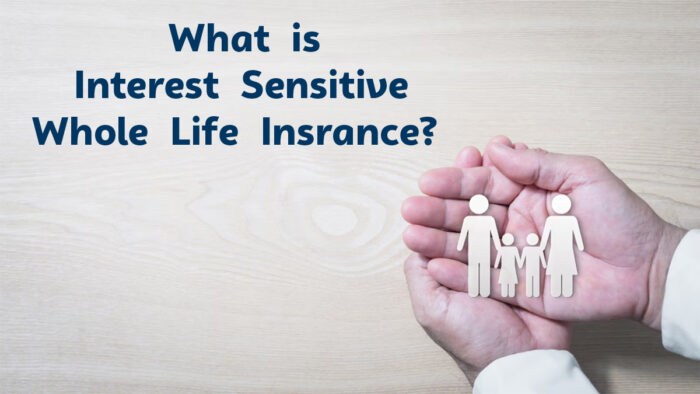Interest-sensitive whole life insurance is a form of policy that combines the security of traditional life insurance with the potential for cash value growth depending on current interest rates.

Instead of a fixed rate, the cash value in this policy can go up rapidly when interest rates rise. This makes it offer a more adaptable option for financial planning than standard term life insurance.
In this guide, we’ll explore interest-sensitive life insurance, how it is different from other policies, and the types available.
Understanding Interest Sensitive Life Insurance
Interest-sensitive life insurance is an incredible one because it blends traditional life insurance features with adjustments based on changes in interest rates.
Unlike standard life insurance that typically offers fixed premiums and a guaranteed death benefit, interest-sensitive policies offer more flexibility in both premiums and death benefits.
With this form of policy, you can also tap into your accumulated cash value while you’re still alive, either by withdrawing funds or taking a loan. And this is something you can’t do with term life insurance, which doesn’t build cash value.
Benefits of Interest-Sensitive Life Insurance
Interest-sensitive life insurance policies offer unique advantages that make them stand out from other types of coverage. Here’s why an individual might decide to go for an interest-sensitive policy:
- Quicker cash value growth: The cash value in these policies acts like a tax-deferred savings account, meaning it can grow faster over time. You don’t need to pay for taxes until you withdraw the money. And even when you withdraw, the taxes only apply if you take out more than you’ve paid in.
- Tax-free death benefit: Just so you know, the death benefit from an interest-sensitive whole life insurance policy is completely tax-free. When the policyholder passes away, the beneficiaries receive the full payout without having to pay anything to the IRS, no matter how much the policy is worth.
- Flexibility in Payments and Benefits: These policies offer the flexibility to adjust premium payments and death benefits, allowing policyholders to choose an affordable payment plan that fits their budget. You can also customize the death benefit to meet your needs and those of your beneficiaries.
Making the Most of Interest-Sensitive Life Insurance
We can really say this policy is a strong option for long-term coverage. Here are a couple of important things to know:
• Minimum guaranteed interest rates
Each policy comes with a minimum guaranteed interest rate, ensuring that your cash value never earns less than a certain amount, even when interest rates are low. When rates are higher, your cash value grows even faster.
• Surrendering the Policy
If you choose to surrender your policy, you’ll receive the surrender value. And which is the current cash value minus any fees. However, surrendering ends the coverage. This means that your beneficiaries won’t receive a death benefit. Also, if the surrender amount exceeds what you’ve paid in, that excess is considered taxable income.
How Interest-Sensitive Life Insurance Differs from Traditional Policies
Just as I have mentioned above, interest-sensitive life insurance offers more flexibility compared to traditional policies with fixed rates. Here’s how they differ:
- Flexibility: With interest-sensitive policies, you can often adjust the death benefit and premiums within certain limits set by the insurance company. This enables you to customize your coverage to fit your needs and budget as they change over time.
- Cash Value Accumulation: These policies come with a minimum guaranteed interest rate for cash value growth, but they also respond to changes in interest rates. When rates are high, your cash value could grow faster than the guaranteed minimum. If rates are low, the growth may slow down, but it will never drop below the guaranteed minimum. Traditional policies, on the other hand, don’t adjust to changes in interest rates.
Similar Types of Life Insurance
Interest-sensitive whole life insurance may go by different names, some of which refer to the same type of policy, while others have specific differences. Here’s a simple breakdown for you:
• Excess interest whole life
This is essentially the same as interest-sensitive whole life insurance, but it comes with a fixed premium. You can’t adjust the premium yourself, but if interest rates rise, the insurance company adds the extra earnings to your cash value. You can use this added cash value to help pay future premiums if you choose.
• Current assumption whole life
With this type of policy, the insurance company regularly reviews factors like interest rates and mortality costs (how many policyholders pass away) to adjust your premiums and cash value growth. Your premiums might go up or down based on these evaluations, which could happen annually or every few years. If costs increase, you can lower your death benefit to keep your premiums the same, but you’ll have less coverage.
• Single premium whole life
This policy requires a one-time lump-sum payment instead of regular premiums. You get lifetime coverage and cash value growth. If interest rates drop after you have purchased the policy, you might need to pay extra to maintain your cash value, although most single premium policies aren’t interest-sensitive and won’t require additional payments.



